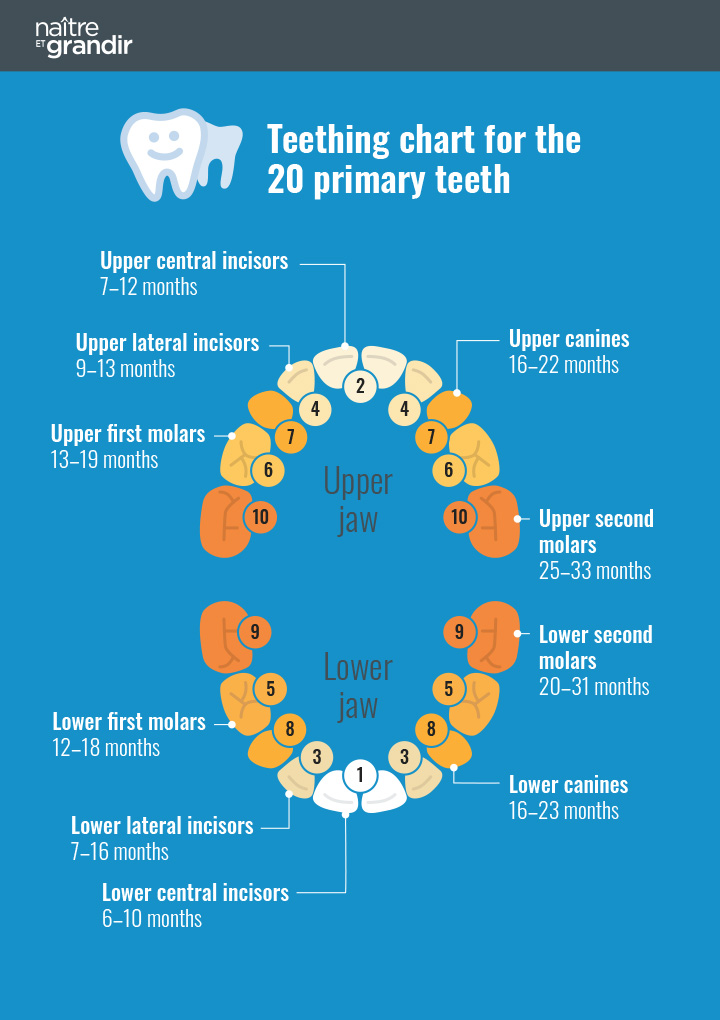Ouch, my gums hurt! How to soothe your baby’s teething pains.
A baby’s first teeth generally come in at 6 months. However, they may appear earlier. Some children are even born with one or two teeth. In some cases, the first teeth don’t come in until 14 months of age.
The onset of teething
Your baby’s teeth begin to develop months, even years, before they come through the gums. The buds of their primary teeth form as early as the 6th week of pregnancy, and those of their permanent teeth begin to develop at around week 10. The different parts of the tooth, such as the enamel and the root, follow a precise pattern of development throughout your pregnancy. However, the buds of the permanent molar teeth develop only after birth. The first permanent molars begin to form at around 4 months of age, with the second permanent molars developing at around age 5.
In most cases, the 20 primary teeth (baby teeth) will come through one after the other until about age 3. The onset of the teething process varies from child to child, but teeth generally appear in the following order:

Meanwhile, the 32 adult teeth continue to develop in the jaws. They usually appear between 6 and 12 years of age. Wisdom teeth usually come in later. In some cases, wisdom teeth may not develop at all.
How can you soothe teething pains?
Discomfort from teething may vary from child to child. In some cases, your baby will show no symptoms. This is often the case with their first teeth. But many babies will show signs of discomfort when they cut a tooth. You may see a bluish cyst on the gum or increased salivation when a tooth is about to break through. These symptoms typically last 24 to 48 hours. For more details, read our fact sheet on teething (link in French).
Contrary to what many people believe, teething does not cause illness or a high fever. If your baby has a high fever, it’s unlikely due to teething, so it’s best to call Info-Santé or a doctor. See our fact sheets if your baby develops a
fever,
diarrhea, or diaper rash.
When teething, your baby may start to chew on their hands and their gums may become slightly inflamed. No treatment is needed if this is the case. However, you can try one of the following simple methods to help relieve discomfort:
-
Gently massage their gums with a clean finger.
-
If they’re drooling and feel the urge to bite, give them a clean washcloth dipped in cold water or a refrigerated teething ring. Don’t cool the ring in the freezer, as a frozen ring could damage your baby’s mouth.
-
If necessary, you can give your baby acetaminophen.
Avoid the following:
- Teething gels. They provide only superficial relief and may interfere with your baby’s ability to swallow.
- Teething biscuits. They do not offer relief, and can cause tooth decay because of the high sugar content.
- Raw vegetables. They can cause choking. Don’t offer your child very firm vegetable pieces until the age of 2.
Caring for baby’s teeth
Good dental hygiene is important from an early age as your child’s dental health will have a positive impact on their life. Healthy teeth will allow them to chew properly and eat all the foods they need to develop. Healthy teeth are also essential for proper language development. And healthy teeth contribute to a healthy self-esteem!
It’s a good idea to get your baby used to brushing as soon as their first teeth appear. This way, brushing will become part of their routine. To learn more about how to care for your baby’s teeth, read our fact sheet on dental hygiene.
According to the Canadian Dental Association, it’s a good idea to start taking your child to the dentist as early as age 1, or 6 months after their first tooth appears, to get them used to dental checkups. In Quebec, the
Régie de l’assurance maladie du Québec covers dental checkups and certain services for all children under 10 years of age.
Sources
Note: The links to other websites are not updated regularly, and some URLs may have changed since publication. If a link is no longer valid, please use search engines to find the relevant information.
-
Doré, Nicole, and Danielle Le Hénaff. From Tiny Tot to Toddler: A practical guide for parents from pregnancy to age two. Quebec City, Institut national de santé publique du Québec. www.inspq.qc.ca
-
Memarpour, M., et al. “Signs and symptoms associated with primary tooth eruption: A clinical trial of nonpharmacological remedies.” BMC Oral Health, 2015, 15:88.
-
Pansky, Ben. “Development of the teeth.” Review of Medical Embryology, 1982, Embryome Science, vol. 6, p. 77.
-
Rossant, Lyonel, and Jacqueline Rossant-Lumbroso. Votre enfant. Guide à l’usage des parents. Paris, Éditions Robert Laffont, coll. “Bouquins”, 2006, 1,508 pp.
-
Canadian Paediatric Society. Caring for Kids. “Healthy teeth for children.” caringforkids.cps.ca
-
Dr. Vekemans, Gaëlle. L’ABC de la santé des enfants. 2nd ed., Montreal, Les Éditions La Presse, 2016, 413 pp.
|